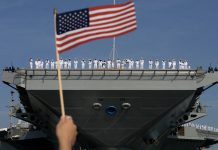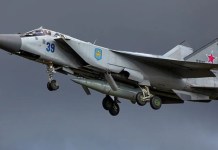A Turkish C-130 military cargo plane with 20 passengers and crew members crashed in Georgia while returning from Azerbaijan, according to the defense ministry.
The ministry stated that its C-130 military cargo plane, en route from Azerbaijan to its home base, went down at the Georgia-Azerbaijan border. It confirmed 20 personnel were on board, including the flight crew.
Search-and-rescue efforts were underway, the ministry noted. Video footage shared in Azerbaijani media captured the plane rotating horizontally as it plummeted from the sky, followed by a massive plume of black smoke upon impact.
Clips from the site depicted the charred wreckage engulfed in flames, observed by onlookers in a nearby field.
Turkey’s defense ministry requested that the media refrain from publishing images of the crash. President Recep Tayyip Erdogan expressed condolences for the lost personnel, whom he called martyrs, and said Turkey was collaborating with Georgian officials to access the wreckage, per the Anadolu state news agency.
❗️Turkish Military Plane Crashes On Georgia-Azerbaijan border – 🇹🇷 MoD
Footage from social media reportedly shows a Lockheed C-130 Hercules spiralling out of control before slamming into the ground. pic.twitter.com/nooh6BKLDN
— RT_India (@RT_India_news) November 11, 2025
Azerbaijan’s President Ilham Aliyev offered his sympathies to the Turkish leader in an X post. Foreign Minister Hakan Fidan discussed the search and rescue with his Georgian counterpart, Maka Bochorishvili, over the phone, according to a ministry statement.
Georgia’s interior ministry verified the incident occurred in the Sighnaghi region, roughly five kilometers from the border with Azerbaijan. The country’s Sakaeronavigatsia air traffic control reported the plane vanished from radar soon after crossing into Georgian airspace, without issuing a distress call.
It launched a search-and-rescue operation immediately and informed Azerbaijan’s Ganja airport—the departure point—and Turkish authorities.
Aviation safety experts are pointing fingers at the aircraft’s “old age”. Defense analyst Babak Taghvaee pored over circulating videos showing the wing and center box detaching from the fuselage.
“This strongly suggests a catastrophic structural failure caused by metal fatigue and fracture in the wing center box area—a known risk in aging C-130 airframes,” Taghvaee wrote, emphasizing that the Turkish fleet includes several such vintage models from the 1960s, often pushed to their limits in high-stress operations.
Similarly, architect and aviation enthusiast Tasos Kourbidis echoed this, noting on social media that “C-130s are notorious for structural fatigue on this part,” a vulnerability documented in U.S. Air Force inspections of similar Hercules variants.

Flight tracking service Flightradar24, in its real-time blog post, corroborated the timeline: the plane, callsign TUAF543, lifted off at 10:19 UTC but vanished minutes later without a distress signal, fueling speculation of a sudden, uncontrollable event.
Broader probes, as reported by UA-Stena, are focusing on mechanical issues or adverse weather over the rugged Caucasus Mountains, where downdrafts could exacerbate structural weaknesses.
Not all takes are purely technical. In the volatile Caucasus—a hotspot of Turkish-Azerbaijani ties amid Russian and Iranian influence—some voices whisper of foul play.
OSINT analyst Shah Faisal Afridi highlighted smoke trails in footage, suggesting possibilities like “an onboard explosion, engine failure, or an external strike,” though he emphasized these await confirmation.
The pro-Russian Militarist Telegram channel, cited by the Daily Mail, went further, claiming the plane “broke apart in mid-air, likely due to an internal explosion,” evoking sabotage theories tied to regional tensions.
Media personality Mario Nawfal amplified this on X, framing the crash as a “fireball over a strategic air corridor” in Turkey’s “quiet empire-building” network, warning that “every intelligence desk from Yerevan to Washington will be reading this wreckage like scripture.”
OSINT account Indus Sentinel Grid described debris patterns that hint at “a possible explosion or impact from a foreign object,” underscoring the flight’s military context after the Baku parade.
As wreckage analysis begins, experts like Taghvaee predict a somber verdict: for a workhorse like the C-130, which serves as Turkey’s logistical backbone, this could accelerate fleet modernization.
By: ET Desk with AFP Inputs




